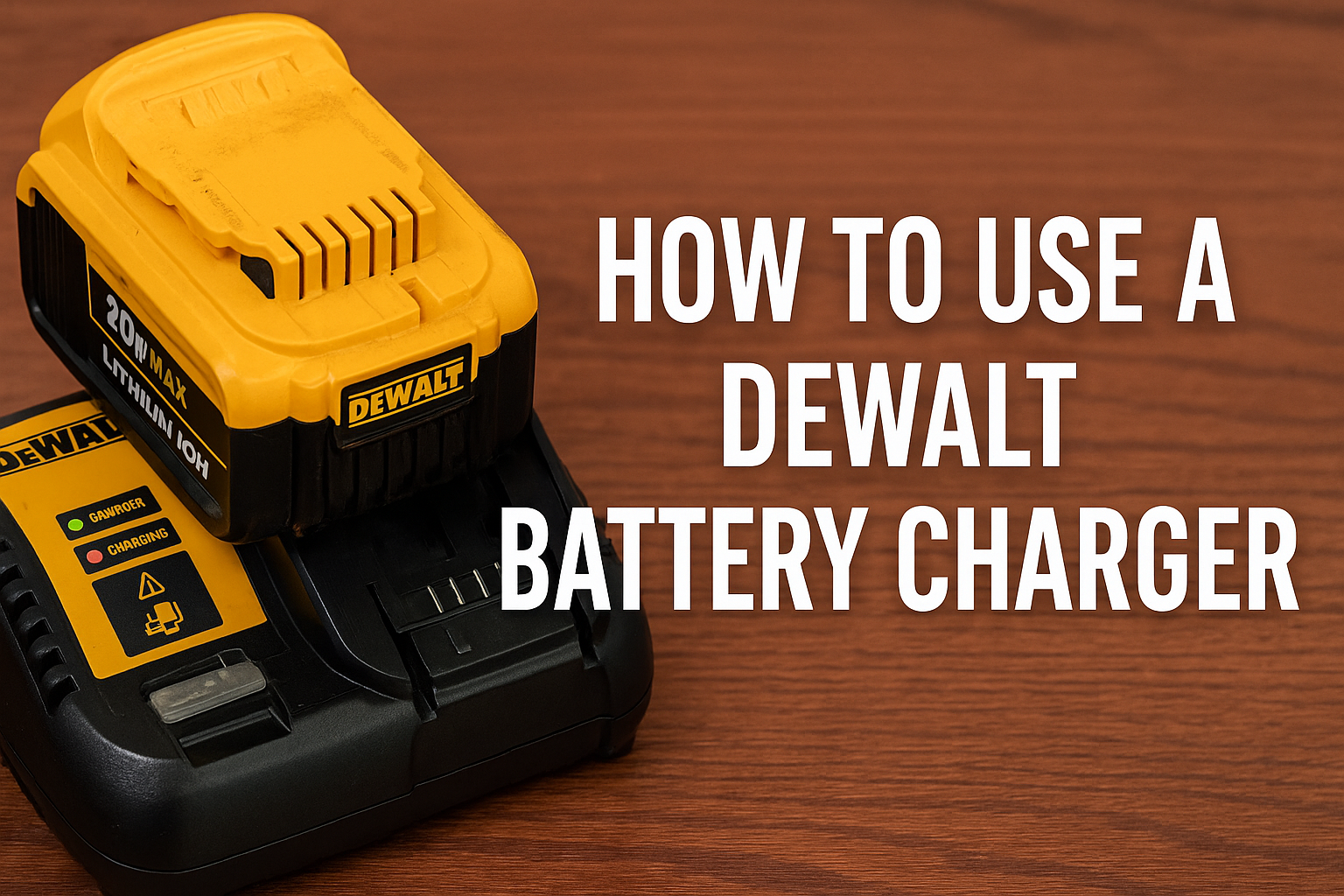When it comes to power tools, DeWalt is one of the most trusted names in the industry. Their range of tools—especially their cordless power tools—has revolutionized the way DIY enthusiasts and professionals work. But even the most powerful cordless tool is useless without a fully charged battery. That’s where the DeWalt battery charger comes in.
Whether you’ve just bought your first DeWalt tool or you’re looking to optimize your battery charging habits, this comprehensive guide will teach you how to use a DeWalt battery charger effectively, safely, and efficiently. Let’s dive in!
📌 Understanding DeWalt Battery Chargers: An Overview
DeWalt offers several battery chargers to complement their XR (Extreme Runtime), FLEXVOLT, and 20V MAX batteries. These chargers are designed for Li-ion (Lithium-ion) batteries, known for their long lifespan, quick charging, and durability.
🔹 Types of DeWalt Chargers:
- Standard Chargers: Basic chargers that come with most tool kits. They offer slower charging speeds.
- Fast Chargers (XR or FlexVolt models): Designed for faster charging times—great for pros needing quick turnaround.
- Dual Port Chargers: Can charge two batteries simultaneously.
- Multi-Voltage Chargers: Can handle different battery voltages (e.g., 12V, 20V, 60V).
🦺 Safety Precautions Before Using a DeWalt Battery Charger
Before plugging in your charger, take these essential safety steps:
✅ Read the Manual: Always refer to the user manual specific to your charger model.
✅ Inspect the Charger and Battery: Check for visible damage, frayed cords, or cracks in the housing.
✅ Dry Environment: Use the charger in a clean, dry, and well-ventilated space.
✅ No Flammable Materials: Keep away from flammable liquids, gases, or materials.
✅ Use Genuine DeWalt Batteries: Avoid third-party or counterfeit batteries to prevent malfunction or hazards.
📝 Step-by-Step Instructions: How to Use a DeWalt Battery Charger
Let’s break down the process into clear, actionable steps.
1️⃣ Identify Your Battery and Charger Compatibility
- DeWalt chargers are generally backward-compatible within the 20V MAX and FLEXVOLT ranges.
- Make sure the charger supports the voltage and model of your battery. For example, a 20V MAX charger won’t charge an older NiCd battery.
2️⃣ Plug in the Charger
- Plug the charger into a standard household outlet (120V in the U.S.).
- Ensure the outlet is grounded and not overloaded with multiple devices.
- Some chargers have LED indicators that light up when powered.
3️⃣ Insert the Battery Correctly
- Align the battery terminals with the slots in the charger.
- Slide the battery into the charger until it clicks into place.
- Avoid forcing the battery—if it doesn’t fit easily, double-check compatibility.
4️⃣ Monitor Charging Progress
DeWalt chargers feature LED indicator lights that communicate the battery’s charging status:
- Flashing Red Light: Charging in progress.
- Solid Red Light: Battery fully charged and ready for use.
- Flashing Red + Yellow Light: Battery is too hot or too cold. Let the battery rest before attempting to charge again.
- No Lights: Either the charger is not receiving power or the battery is not properly seated.
5️⃣ Remove the Battery When Fully Charged
- Once the red light turns solid, gently remove the battery by pressing the release button (if applicable) and sliding it out.
- Avoid leaving the battery in the charger indefinitely—it won’t harm the battery, but it’s a good habit to remove it to prevent potential overcharging (especially with older models).
🔋 How Long Does It Take to Charge a DeWalt Battery?
Charging times depend on:
- Battery Capacity (Ah): A 1.5Ah battery will charge faster than a 5.0Ah battery.
- Charger Type: Fast chargers significantly reduce charge time.
- Battery Temperature: Extreme temperatures can slow down charging.
Here’s a rough estimate:
- 1.5Ah battery: 30-45 minutes on a standard charger, 20-30 minutes on a fast charger.
- 4.0Ah battery: 60-90 minutes on a standard charger, 40-60 minutes on a fast charger.
- 6.0Ah FLEXVOLT battery: 90-120 minutes on a standard charger, 60-90 minutes on a fast charger.
🚫 Common Mistakes to Avoid
❌ Using Damaged Batteries or Chargers: This can lead to fire hazards or equipment damage.
❌ Charging in Extreme Temperatures: Don’t charge batteries below 40°F (5°C) or above 105°F (40°C).
❌ Using Non-DeWalt Batteries: Generic or counterfeit batteries may not charge properly or could damage the charger.
❌ Forcing the Battery into the Charger: Align the battery properly to avoid damaging terminals.
❌ Overcharging Older Models: While modern DeWalt chargers stop charging automatically, older models may not. Remove batteries once charged.
💡 Pro Tips for Optimal Charging
🔸 Use the Right Charger: For quick charging, invest in a DeWalt fast charger or dual-port charger.
🔸 Keep Batteries at Room Temperature: Store batteries indoors to maintain ideal charging conditions.
🔸 Charge Before Full Depletion: Li-ion batteries last longer if recharged before they are completely drained.
🔸 Regular Maintenance: Clean battery contacts and charger slots with a dry cloth to ensure proper connection.
🔸 Rotate Batteries: If you own multiple batteries, rotate usage to extend overall lifespan.
🧰 Troubleshooting: What If Your DeWalt Battery Won’t Charge?
If your battery won’t charge, consider these possible causes:
🔍 Dirty Terminals: Clean the metal contacts with a dry cloth.
🔍 Battery Too Hot or Cold: Let the battery acclimate to room temperature.
🔍 Charger Not Working: Test the charger with a different battery. If the issue persists, replace the charger.
🔍 Battery Failure: Batteries degrade over time. If a battery won’t hold a charge after multiple attempts, it may need replacement.
🔍 LED Error Codes: Refer to the manual for specific flashing light patterns.
🏆 Why Choose a DeWalt Battery Charger?
DeWalt chargers stand out because:
- Fast and Efficient: Save time with fast-charging models.
- Smart Charging: Built-in sensors prevent overcharging and optimize battery health.
- Durability: Rugged construction for jobsite use.
- Compatibility: Works with a wide range of DeWalt tools and battery platforms.
Whether you’re a contractor on a tight schedule or a DIYer working on weekend projects, DeWalt chargers keep you powered up.
🔧 Maintaining Your DeWalt Battery Charger
A few simple maintenance tips will extend the lifespan of your charger:
- Keep It Clean: Wipe down with a dry cloth—never use water or solvents.
- Store Safely: Avoid high humidity or dusty environments.
- Inspect Regularly: Look for frayed cords or damaged housings.
- Use in Proper Conditions: Avoid outdoor use during rain or extreme temperatures.
🛠️ Conclusion: Charge Smart with DeWalt
Mastering your DeWalt battery charger is key to maximizing the performance of your cordless tools. By following the steps outlined in this guide, you’ll keep your batteries charged, your tools ready, and your projects running smoothly.
Remember to always use genuine DeWalt batteries and chargers, follow safety guidelines, and store your equipment properly. With these tips, you’ll extend the life of both your batteries and charger—and ensure your power tools are always ready to perform.

